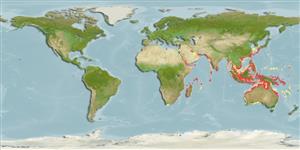>
Carangiformes (Jacks) >
Carangidae (Jacks and pompanos) > Caranginae
Etymology: Caranx: French, carangue, the name of a Caribbean fish; 1836 (Ref. 45335).
Environment: milieu / climate zone / depth range / distribution range
Ökologie
seewasser; brackwasser riff-verbunden; standorttreu. Tropical; 34°N - 39°S, 19°E - 168°E
Indo-West Pacific: East Africa and Madagascar to Fiji, north to the Ryukyu Islands, south to northern Australia.
Length at first maturity / Size / Gewicht / Alter
Maturity: Lm 50.0 range ? - ? cm
Max length : 88.0 cm TL Männchen/unbestimmt; (Ref. 90102); common length : 30.0 cm TL Männchen/unbestimmt; (Ref. 5450); max. veröff. Gewicht: 12.5 kg (Ref. 11228)
Rückenflossenstacheln (insgesamt): 9; Rückenflossenweichstrahlen (insgesamt): 19-21; Afterflossenstacheln 3; Afterflossenweichstrahlen: 15 - 17. Dark bronze to yellow-green dorsally, shading to silvery bronze to yellowish or yellow green ventrally (Ref. 48635, 90102), yellow to dusky caudal fin and usually outer half of upper caudal lobe black (especially in juvenile) (Ref. 90102). Identified by black-tipped caudal fin (Ref. 48635). Body oblong and compressed, dorsal profile strongly convex to second dorsal fin, ventral profile slightly convex. Breast scalation variable, completely scaly (uncommon) to scaleless ventrally (Ref. 90102). LL with 30-40 strong scutes (Ref. 48635, 90102). Adipose eyelid moderately developed, small anteriorly and extending forward to rear edge of pupil o posterior part of eye. (Ref. 90102)
Adults inhabit clear coastal waters, over rocky reefs in small aggregations (Ref. 5213). Seldom found in turbid or estuarine waters. May be found solitary (Ref. 90102). They feed on fishes and crustaceans (Ref. 5213). Sold fresh and dried salted in markets. Excellent food fish if cooked properly (Ref. 12484).
Life cycle and mating behavior
Geschlechtsreife | Fortpflanzung | Ablaichen | Eier | Fecundity | Larven
Fricke, R., 1999. Fishes of the Mascarene Islands (Réunion, Mauritius, Rodriguez): an annotated checklist, with descriptions of new species. Koeltz Scientific Books, Koenigstein, Theses Zoologicae, Vol. 31:759 p. (Ref. 33390)
IUCN Rote Liste Status (Ref. 130435)
Bedrohung für Menschen
Harmless
Nutzung durch Menschen
Fischereien: weniger kommerziell; Sportfisch: ja
Mehr Information
ReferenzenAquakulturAquakultur ProfilZuchtlinienGenetikElectrophoresesVererbbarkeitKrankheitenVerarbeitungNutrientsMass conversion
Tools
Zusatzinformationen
Download XML
Internet Quellen
Estimates based on models
Preferred temperature (Ref.
123201): 23.9 - 29, mean 27.9 °C (based on 1214 cells).
Phylogenetic diversity index (Ref.
82804): PD
50 = 0.5000 [Uniqueness, from 0.5 = low to 2.0 = high].
Bayesian length-weight: a=0.02089 (0.01183 - 0.03689), b=2.94 (2.80 - 3.08), in cm total length, based on LWR estimates for this species & Genus-body shape (Ref.
93245).
Trophic level (Ref.
69278): 4.0 ±0.57 se; based on food items.
Widerstandsfähigkeit (Ref.
120179): mittel, Verdopplung der Population dauert 1,4 - 4,4 Jahre. (Preliminary K or Fecundity.).
Fishing Vulnerability (Ref.
59153): High vulnerability (55 of 100).
Nutrients (Ref.
124155): Calcium = 18.6 [8.4, 35.4] mg/100g; Iron = 0.363 [0.197, 0.695] mg/100g; Protein = 19.9 [17.7, 22.4] %; Omega3 = 0.133 [0.079, 0.226] g/100g; Selenium = 53 [27, 112] μg/100g; VitaminA = 62.6 [19.7, 193.6] μg/100g; Zinc = 0.569 [0.413, 0.857] mg/100g (wet weight);
